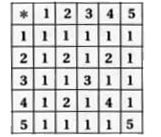Let f:R→R be the Signum Function defined as f(x)=⎧⎪⎨⎪⎩1x>00x=0−1x<0 and g:R→R be the Greatest Integer Function given by g(x) = [x] , where [x] is greatest integer less than or equal to x. Then , does fog and gof coincide in (0,1] ? Solution in Gujrati
Yes
No
Nothing can be said
Composite function does not exists
The correct Answer is:B
Step by step video, text & image solution for Let f : R rarr R be the Signum Function defined as f(x) = {(1,xgt0),(0,x = 0),(-1,xlt0):} and g : R rarr R be the Greatest Integer Function given by g(x) = [x] , where [x] is greatest integer less than or equal to x. Then , does fog and gof coincide in (0,1] ? by Maths experts to help you in doubts & scoring excellent marks in Class 12 exams.
Updated on:21/07/2023Topper's Solved these Questions
- RELATIONS AND FUNCTIONS BOOK - KUMAR PRAKASHANCHAPTER - RELATIONS AND FUNCTIONS EXERCISE - Practice Work
66 Videos
- RELATIONS AND FUNCTIONS BOOK - KUMAR PRAKASHANCHAPTER - RELATIONS AND FUNCTIONS EXERCISE - Textbook based MCQs
64 Videos
- RELATIONS AND FUNCTIONS BOOK - KUMAR PRAKASHANCHAPTER - RELATIONS AND FUNCTIONS EXERCISE - EXERCISE 1.4
25 Videos
- PROBABILITYBOOK - KUMAR PRAKASHANCHAPTER - PROBABILITYEXERCISE - Practice Paper - 13 (Section - D (Answer the following questions))
2 Videos
- THREE DIMENSIONAL GEOMETRYBOOK - KUMAR PRAKASHANCHAPTER - THREE DIMENSIONAL GEOMETRYEXERCISE - PRACTICE PAPER -11
16 Videos
Similar Questions
The relation R defined in the set of real number R is as follow :
R{(x,y):x−y+√2 is an irrational number}
Is R transitive relation ?
View SolutionIf a set A has m elements and a set B has n elements then the number of relation from a to B is ...........
View SolutionConsider a binary operation ∗ on the set {1,2,3,4,5} given by the following multiplication table.
(i) Compute (2*3)*4and2*(3*4)
(ii) Is ∗ commutative ?
(iii) Compute (2*3)*(4*5)
(Hint: use the following table )

View SolutionIn a game, a man wins a rupee for a six and loses a rupee for any other number when a fair die is thrown. The man decided to throw a die thrice but to quit as and when he gets a six. Find the expected value of the amount he wins/loses.
View SolutionFind the direction cosines of a line which makes equal angles with the coordinate axes.
View SolutionLet f:R→R be the Signum Function defined as f(x)={1,x>0;0,x=0;−1,x<1 and g:R→R be the Greatest Integer Function given by g(x)=[x], where [x] is greatest integer less than or equal to x. Then does fog and gof coincide in (0,1]
View SolutionLet f:[-(1)/(2),2]rarr R and g:[-(1)/(2),2]rarr R be functions defined by f(x)=[x^(2)-3] and g(x)=|x|f(x)+|4x-7|f(x), where [y] denotes the greatest integer less than or equal to y for y in R. Then,
View SolutionIf f:R rarr R and g:R rarr R defined f(x)=|x| and g(x)=[x-3] for x in R[.] denotes the greatest integer function
View SolutionIf the function f:R rarr R be such that f(x)=x-[x], where [x] denotes the greatest integer less than or equal to x, then f^(-1)(x) is
View SolutionLet f:R→R be the signum function defined as f(x)={1, x>0, 0, x=0, −1, x<0 and g:R→R be the greatest integer function given by g(x)=[x] . Then, prove that fog and gof coincide in (0, 1] .
View Solutionf:R rarr R,g:R rarr R are defined as f(x)=|x|,g(x)=[x]AA x in R[*] is denotes greatest integer function then {x in R:g[f(x)]<=f[g(x)]}=
View Solutionमाना f : R → R निम्न प्रकार से परिभाषित चिन्ह फलन हैं -
f(x)=⎧⎪⎨⎪⎩1,x>00,x=0−1,x<0
तथा g : R → R , g (x) = [ x ] व्दारा प्रदत्त महत्तम पूर्णांक फलन हैं , जहाँ [ x ] , x से कम या x के बराबर पूर्णांक हैं , तो क्या fog और gof , अंतराल [ 0 , 1] में संपाती हैं ?
View SolutionLet f:R→R be the Signumb Function defined as
f(x)=⎧⎪⎨⎪⎩1,x>00,x=0−1,x<0
and g:Ro→R be the Greatest Integer Function given by g(x)=[x], where [x] is greatest integer less than or equal to x. Then does fog and gof coincide in (0,1]?
View SolutionLet f: R → R be the Signum Function defined as f(x)={ 1, x>0 0, x=0−1, x<1 and g: R→ R be the Greatest Integer Function given by g(x) = [x], where [x] is greatest integer less than or equal to x. Then does fo and of coincide in (0, 1]?
View SolutionLet f:R→R be the Signum Function defined as
f(x)=⎧⎪⎨⎪⎩1,x>00,x=0−1,x<0
and g:R→R be the Greatest Integer Function given by g(x)=[x], where [x] is greatest integer less than or equal to x. Then does fog and gof coincide in (0,1]?
View Solution